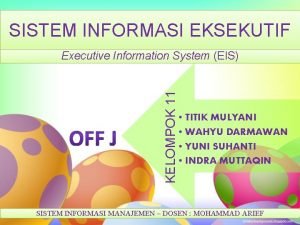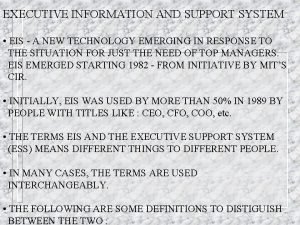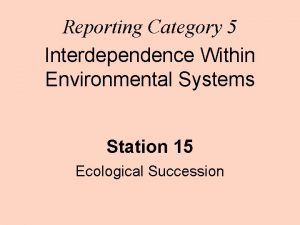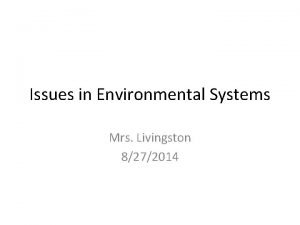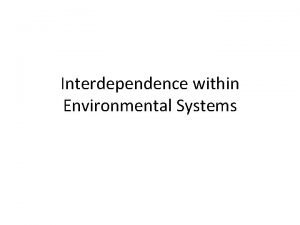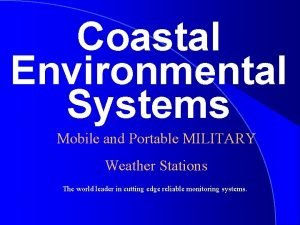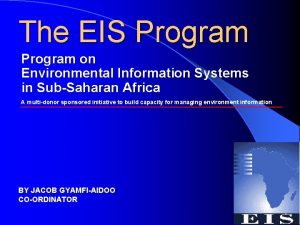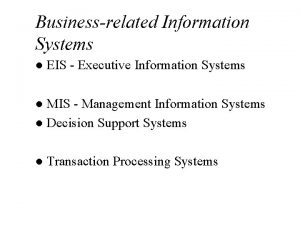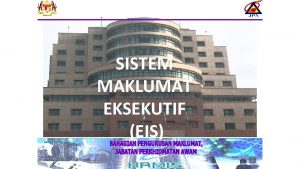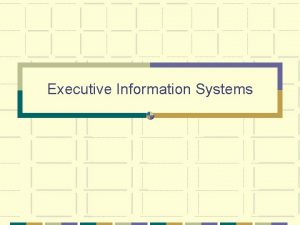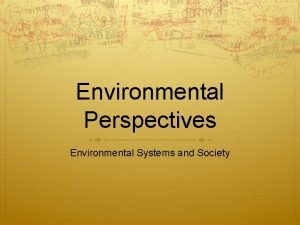The EIS Program on Environmental Information Systems in












- Slides: 12

The EIS Program on Environmental Information Systems in Sub-Saharan Africa A multi-donor sponsored initiative to build capacity for managing environment information BY JACOB GYAMFI-AIDOO CO-ORDINATOR

Environment Information Systems ¢ Defined as “the institutional and technical framework, essential for improving the flow and use of information in environmental management. ” ¢The framework includes: ìStrategies ìPolicies and procedures ìCore data sets and data management tools ìCommunication and networking mechanisms

Program Features ¢ Adoption of a common approach for each ¢ ¢ ¢ participating country Strong local participation and consensus-building Focus on the development of human resources Problem-focus within a clearly defined policy framework Building upon existing national data systems Strong donor participation and co-ordination

Coverage EIS Program IGAD (RIIS) REIMP SADC/RRSU South Africa (NSIF)

Achievements The main achievements of the EIS Program include: ¢ Awareness creation ¢ Contributing to knowledge through country case studies ¢ Promoting data standardisation and harmonisation ¢ Promoting the concept of shared data resources at the national level ¢ Networking


DECISIONS INFORMATION DATA FIELD T E C H N O L O G Y INSTITUTIONAL FRAMEWORK

Lessons Learnt ¢ Adoption of the distributed (enterprise GIS) model ì Common data infrastructure ì Custodianship of data ¢Framework approach ìPrinciples and norms ìStandards ¢Long-term perspective, founded on consensus building

Data Harmonisation ¢ Networking and co-ordination ¢ Country-At-A-Glance data sets ìGhana (completed) ìCôte d’Ivoire (under construction) ìUganda (interest expressed) ¢RRSU CD-ROM ìHarmonised data set for SADC

Challenges ¢ Remaining relevant to the changing needs of countries, sub- regions and Africa as a whole ¢ Shifting from project-orientation to responding to strategic policy frameworks ¢ Supporting countries in meeting their global obligations (conventions, etc. ) ¢ Building linkages and synergy among initiatives ¢ Adapting to changes in information technology

Future Perspectives ¢ Incorporation ì Pan-African NGO (EIS Network) ¢ Strategy ì Partnership ì Services to members and partners ì Facilitation, geo-information brokerage and leveraging ì Support for studies or policy-research ì Effective networking

Coordinates The EIS Program, c/o CSIR-Environmentek, Building 33, Room N 254, P. O. Box 395, Pretoria 0001 Republic of South Africa Tel: Fax: Em: URL: +27 -12 -349 1068 +27 -12 -349 2080 eis. program@mweb. co. za http: //www. grida. no/prog/global/eis-ssa/
 Eu te peço que tu me convertas o coração
Eu te peço que tu me convertas o coração Requiem aeternam donai domine
Requiem aeternam donai domine Kelebihan dan kekurangan eis
Kelebihan dan kekurangan eis Characteristics of executive information system
Characteristics of executive information system Mh 605
Mh 605 Category 5 interdependence within environmental systems
Category 5 interdependence within environmental systems Category 5 interdependence within environmental systems
Category 5 interdependence within environmental systems Dryrooms
Dryrooms Environmental systems teks
Environmental systems teks Interdependence within environmental systems
Interdependence within environmental systems What is an environmental value system
What is an environmental value system Coastal environmental systems
Coastal environmental systems Building environmental systems
Building environmental systems


